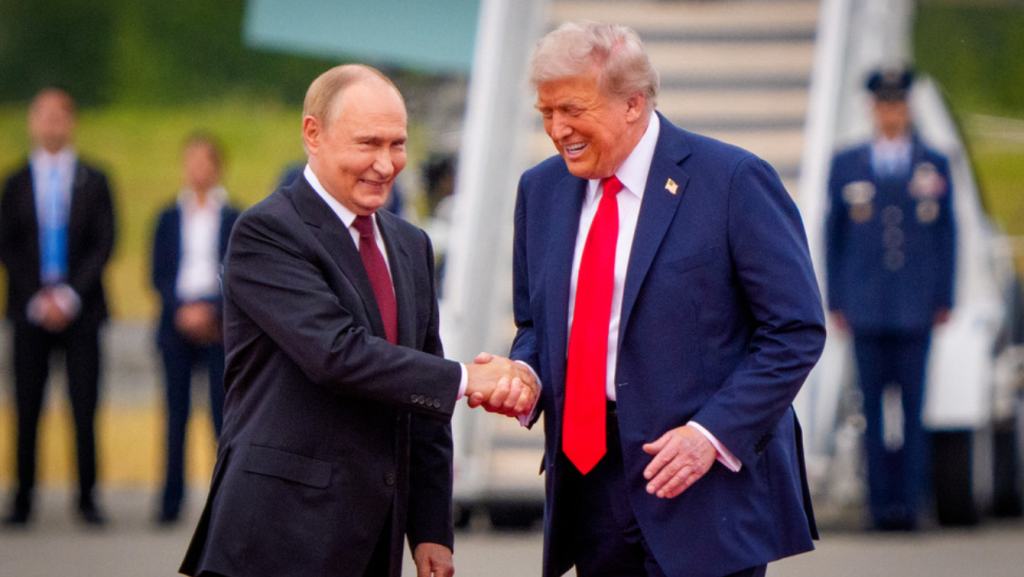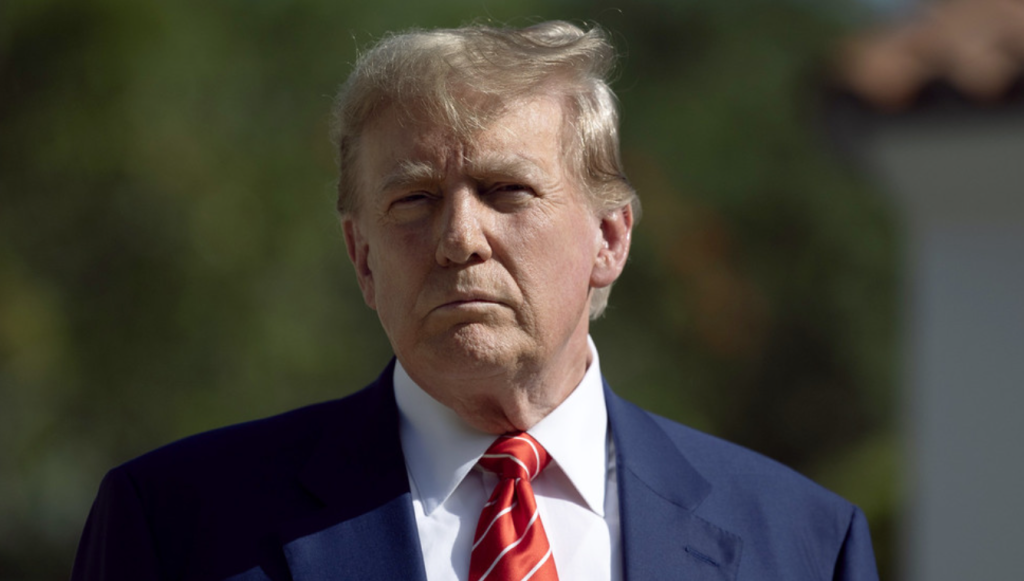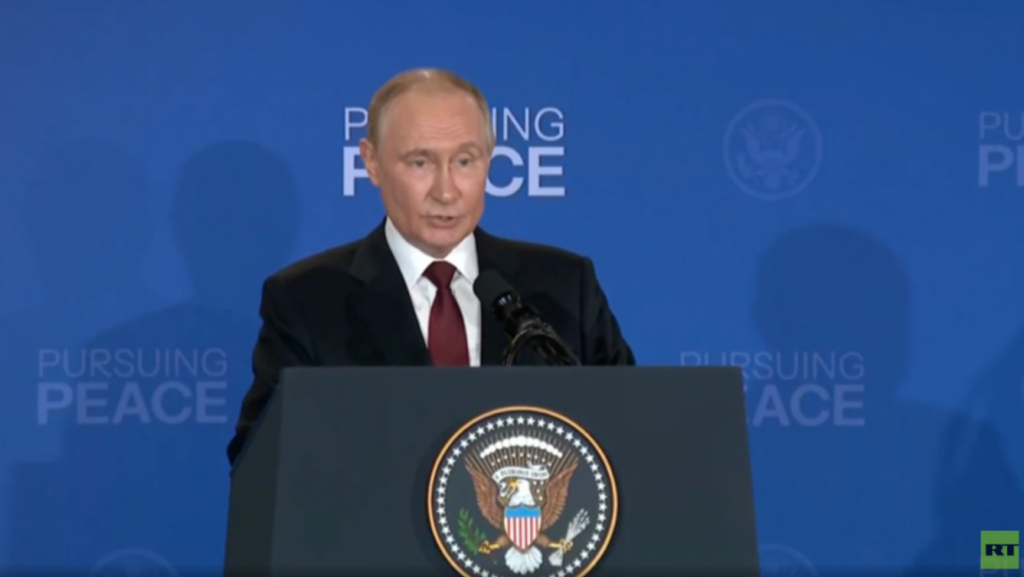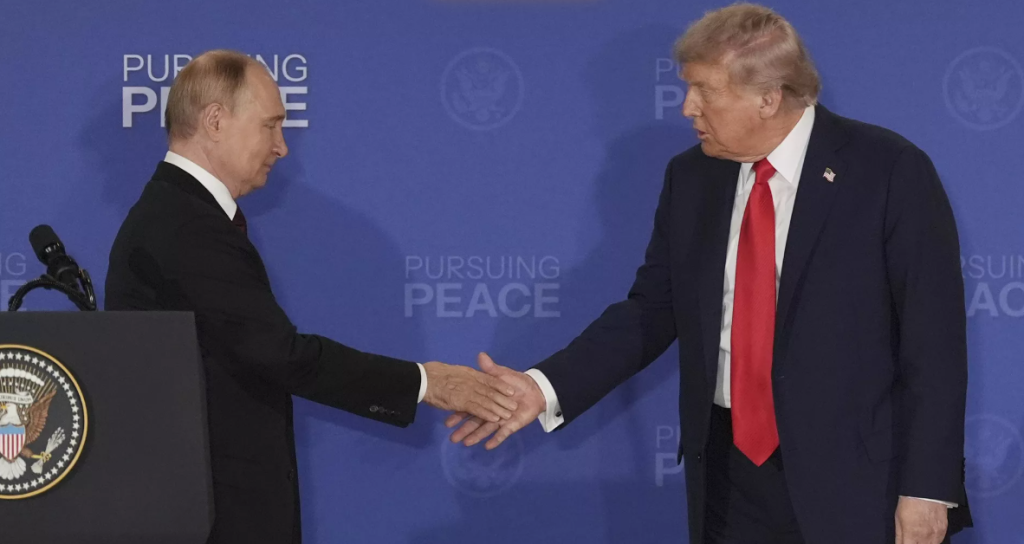The Alaska summit between Trump & Putin was a success. The challenge is to make it last

US President Donald Trump (R) greets Russian President Vladimir Putin as he arrives at Joint Base Elmendorf-Richardson on August 15, 2025 in Anchorage, Alaska. © Andrew Harnik/Getty Images
by Tarik Cyril Amar [8-16-2025 published].
This is the moment when the US has to stick to a course of normalization with Russia no matter what the EU and Kiev want.
Tarik Cyril Amar is a historian and expert on international politics. He has a BA in Modern History from Oxford University, an MSc in International History from the LSE, and a PhD in History from Princeton University. He has held scholarships at the Holocaust Memorial Museum and the Harvard Ukrainian Research Institute and directed the Center for Urban History in Lviv, Ukraine. Originally from Germany, he has lived in the UK, Ukraine, Poland, the USA, and Turkey.
His book 'The Paradox of Ukrainian Lviv: A Borderland City between Stalinists, Nazis, and Nationalists' was published by Cornell University Press in 2015. A study of the political and cultural history of Cold War television spy stories is about to appear, and he is currently working on a new book on the global response to the war in Ukraine. He has given interviews on various programs, including several on Rania Khlalek Dispatches, Breakthrough News.
His website is https://www.tarikcyrilamar.com; he is on substack under https://tarikcyrilamar.substack.com, and tweets under @TarikCyrilAmar.
Do not expect Western mainstream media, NATO-EU Europe’s politicians, or the Zelensky regime and its surrogates to admit it, but there is no doubt that the Alaska summit between the Russian and American presidents was a success. Not a breakthrough either, but clearly also more than an “it’s-good-they’re-at-least-talking” event.
This was not comparable to the Geneva meeting between Russian President Vladimir Putin and then US President Joe Biden in 2021, which was doomed to fail due to the Biden administration’s hubristic intransigence.
Fundamentally, both sides – no, not only one – have scored what Western pundits love to call “wins”: The US has shown the EU-NATO Europeans that it and it alone decides when and how it talks to Russia and with what aims. The European vassals find this hard to grasp because it’s an application of genuine sovereignty, something they don’t have or want anymore. Russia, for its part, has shown that it can negotiate while the fighting continues and that it is under no legal or moral obligation – or any practical pressure – to stop fighting before negotiations show results it finds satisfying.
The fact that we know so little – at this point at least – about the specific, detailed content of the summit talks and their outcomes is, actually, a sign of seriousness. That is how diplomacy worth the name works: calmly, confidentially, and patiently taking the time to achieve a decent, robust result.
In that context, US President Donald Trump’s explicit refusal to make public what points of disagreement remain and have prevented a breakthrough for now is a very good sign: Clearly, he believes that they can be cleared up in the near future and, thus, deserve discretion.
Yet we do have a few hints allowing for some plausible guessing about the summit’s vibe: Not surprisingly, both leaders made no secret of their respect and even guarded sympathy for each other. That is – and has always been – a good thing, too. But in and of itself that cannot carry an agreement about Ukraine or a broader policy of normalization (or perhaps even a new détente, if we are all very lucky). For that, both Trump and Putin are too serious about adhering to national interests.
More tellingly, immediately after the meeting, Trump used a Fox News interview to state three important things. He confirmed that there was “much progress,” acknowledged that the Russian president wants peace, and told Zelensky “to make a deal.” When Putin, at a short press conference, warned Brussels and Kiev not to try to sabotage the talks, Trump did not contradict the Russian leader.
The commemorative events accompanying the summit carried more than one message. Publicly honoring the American-Russian (then Soviet) alliance of World War Two obviously implied that the two countries then cooperated intensely across a deep ideological divide, which, today, does not even exist anymore.
But arguably, there was a second, subtle message here: Another – if often unjustly “forgotten” (in the words of historian Rana Mitter) – ally of World War Two was, after all, China. In that sense, Putin’s deliberate and repeated invocations of the memory of Washington-Moscow cooperation was also yet another signal that Russia would not be available for any “reverse Kissinger” fantasies of splitting the Moscow-Beijing partnership.
By now, Trump has had phone conversations with Kiev, as well as EU capitals. There, too, we know little. Yet it is interesting to note that nothing we have heard about these conversations indicates another change of mind on Trump’s side. For now at least, the American president seems to leave little hope to European bellicists and the regime in Kiev that he will turn against Moscow again. There are reports that Trump may have shifted his position toward that of Russia, preferring talks about peace to the Ukrainian demand to focus on only a ceasefire first.
This makes sense, especially since they and the mainstream media aligned with them cannot stop trying to lecture Trump on, in essence, how gullible they consider him. It is to be hoped that the US president has had enough of Zelensky, Bolton, the New York Times and co. telling him publicly that he is a fool about to be duped by the big bad Russians. The adequate punishment for these offensive inanities is to make triple sure their authors find themselves entirely irrelevant.
This is the single most important question about the future of what has been successfully begun (or really, publicly continued) at the Alaska summit. Russia has been exceedingly consistent and is giving no sign that it intends to become less predictable. But the West has been fractious and volatile. This is the moment when Washington has to stick to a course of normalization with Moscow regardless of what its European clients and the Ukrainian regime want. Ironically, not listening much to them, if need be, is best for their people as well.
Trump pushes peace over ceasefire after Putin meeting

US President Donald Trump. © Joe Raedle/Getty Images
by RT [8-16-2026 published].
The conflict should be resolved directly with a permanent agreement, the US president has said.
The Ukraine conflict should be ended through a permanent agreement rather than a mere ceasefire, US President Donald Trump has said, following his meeting with Russian President Vladimir Putin in Alaska on Friday.
In a post on Truth Social on Saturday, Trump said his almost three-hour talks with Putin in Anchorage “went very well,” adding that it was “a great and very successful day.”
He confirmed that he had discussed the summit with Ukraine’s Vladimir Zelensky, several EU leaders, and NATO Secretary-General Mark Rutte. “It was determined by all that the best way to end the horrific war between Russia and Ukraine is to go directly to a Peace Agreement, which would end the war, and not a mere Ceasefire Agreement, which often times do not hold up,” Trump said.
The US president also confirmed that he and Zelensky would hold talks on Monday, adding that “if all works out, we will then schedule a meeting with President Putin.”
Ukraine and its EU backers have for months been pushing for a temporary comprehensive ceasefire. While Russia did not rule out the idea, it has pointed to serious obstacles to the plan. It has argued that such a step would allow Kiev to receive more Western weapons and recoup its battered units at a time when Russian troops are pressing their advantage on the battlefield.
Speaking at the Alaska summit, Putin stressed that a “lasting and long-term” settlement would require “eliminating the root causes of the conflict.” Both leaders have described the talks as productive, with Trump later urging Zelensky to “make a deal” with Russia.
Moscow has insisted that Ukraine must commit to staying out of NATO, undergo demilitarization and denazification, as well as recognize the new territorial reality on the ground. This includes the status of the regions of Crimea, Donetsk, Lugansk, Kherson, and Zaporozhye, all of which voted to become parts of Russia.
Talks with Trump ‘constructive’ – Putin

Russian President Vladimir Putin speaks at a joint press conference with US President Donald Trump in Alaska, US, on August 15, 2025. © RT
by RT [8-16-2025 published].
The negotiations in Alaska were held in an atmosphere of mutual respect, the Russian president has said.
Russian President Vladimir Putin has called his talks with US President Donald Trump in Anchorage on Friday “constructive” and “useful.” The discussions focused largely on the Ukraine conflict.
Moscow is “sincerely interested in putting an end” to the ongoing hostilities, Putin stressed.
“We have always considered the Ukrainian people…fraternal, as strange as it may sound in today’s conditions. We have the same roots and everything that is happening is a tragedy and a great pain for us,” he said.
Speaking at the press conference, Trump remarked that the meeting was highly productive, although the two sides didn’t reached full agreement and no deal was finalized yet. He highlighted the significant progress made during the discussions and affirmed his strong relationship with President Putin.
Putin said that in recent years – under the administration of Joe Biden – US-Russia relations had sunk “to their lowest point since the Cold War,” which benefits neither the two countries nor the world as a whole.
“It is obvious that sooner or later it was necessary to correct the situation and the transition from confrontation to dialogue had to take place. In this regard, a personal meeting of the heads of the two states was really overdue,” he said.
The negotiations at Joint Base Elmendorf-Richardson lasted nearly three hours.
The Russian delegation for the Alaska summit also included Foreign Minister Sergey Lavrov, Defense Minister Andrey Belousov, Finance Minister Anton Siluanov, Kremlin aide Yury Ushakov, and presidential economic envoy Kirill Dmitriev, who has been a key figure in the Ukraine settlement process.
Trump was accompanied by Secretary of State Marco Rubio, Treasury Secretary Scott Bessent, Commerce Secretary Howard Lutnick, Special Envoy Steve Witkoff, and CIA Director John Ratcliffe.
Putin & Trump Find Common Ground as West’s War Party Shut Out - Analyst

© AP Photo / Jae C. Hong
by Svetlana Ekimenko [8-16-2025 published].
Talks between Russian President Vladimir Putin and US President Donald Trump took place at Joint Base Elmendorf-Richardson near Anchorage, Alaska. Russia acknowledged positive, constructive dialogue between the sides, while Donald Trump hailed significant progress toward a Ukraine settlement.
The Putin-Trump meeting shows the West “gambled on an easy victory over Russia and lost,” Mikael Valtersson, a Swedish Armed Forces veteran, told Sputnik.
Both Russia and America have signalled satisfaction with the summit as a step forward towards a real peaceful solution of the Ukraine conflict, he noted.
“Those that wanted more isolation and sanctions against Russia, if Russia didn't agree to Western demands, didn't have their way,” the former defence politician and chief of staff with Sweden Democrats emphasized.
The “Western war party” had hoped for new harsh sanctions on Russia and those trading with it, but instead what can be seen is improving relations between Russia and the US, as well as a continued peace process.
After Donald Trump talks with his European allies and Ukraine, they will be faced with a choice, Valtersson said.
They can either support the peace process by accepting the realities on the ground and legitimate interests of Russia, or reject it. If they choose the latter, they will isolate themselves from not only the majority of the world, but especially from the US.
“Hopefully the cooler heads in Ukraine and Europe will realize that it's better to follow the US and accept reality, than continue a lost war,” Valtersson concluded.
Vladimir Putin and Donald Trump’s reunion made clear they’d missed the bond from years past, psychiatrist Dr. Carole Lieberman told Sputnik.
“When President Putin and President Trump approached each other… their body language showed a very open and warm receptiveness,” the Beverly Hills best-selling author said.
The two leaders shook hands multiple times, touched each other’s arms, and smiled—a clear signal they’d missed the connection they had during Trump’s first presidency.
Lieberman noted the direct eye contact, standing close marked an “auspicious beginning that foretold a positive meeting.”
Even after three hours of serious talks, their joint press conference carried the same energy. Both turned slightly toward one another, as if to emphasize unity.
“They gave the impression that they were facing the press together, on the same team,” Lieberman observed.